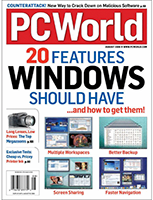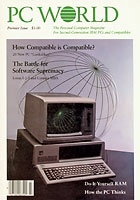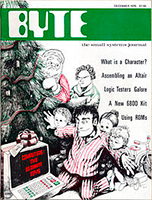In the most interesting historic PCWorld photo I have, from late 1982 or early 1983, Bill Gates talks about MS-DOS 2.0 with PCW staffers. From left: Microsoft’s Chris Larson, PCW’s Steve Cook, Gates, Microsoft's Tandy Trower and founding PCW editor Andrew Fluegelman.
The news isn’t shocking. In fact, it’s sort of a shock it didn’t happen several years ago. After slightly more than thirty years in print, PCWorld magazine is ceasing publication, effective with the current issue, to focus on its website and digital editions.
If I have to explain why, you haven’t been paying attention to the media business for the past decade or so. The web has been awfully hard on magazines, and no category has suffered more than computer publications. Both readers and advertisers have largely moved online. Many of them did so years ago — especially the sort of tech-savvy people who once read PC magazines. At the end, PCWorld was about a quarter the size it once was in terms of pages and had lost two-thirds of its readership. I don’t even want to think about what had happened to its profits.
I spent thirteen and a half years writing and editing for PCWorld, from 1994-2008, as an employee of its publisher, IDG. (It was called PC World back in my day, and I still wince slightly every time I type the name without a space.) So you might think I’d consider the news of the magazine’s end to be something akin to a death in the family.
Actually, it seems like an unalloyed good to me. IDG says it won’t lay off any employees as a result of the print exit; the PCW staff will now get to make PCWorld.com as useful as it can be, without being forced to tend to a publication which could never be what it once was.
I remain proud of the work we did at PCW, and feel inordinately lucky to have spent time there during the boom times for printed computer publications. But in 2013, with the possible exception of long trips on airplanes which don’t have wi-fi, I simply can’t think of a reason why anyone would want to read a monthly magazine about PCs and related products. And there’s no reason to feel sad about an obsolete product in the final stages of permanent long-term decline going away.
(Yes, I’m aware I work for TIME, a publication which still publishes on dead trees as well as on the web. I’m not arguing that magazines are obsolete, period. For a variety of reasons — subject matter, frequency, editorial turnaround time, advertising base — a newsweekly can still make sense in a way that a computer monthly cannot. But if this were easy, Newsweek and U.S. News and World Report would still be doing it.)
PCWorld‘s paper-based demise may be inevitable and, in a way, liberating. But it’s also the end of an era. Its arch-rival, PC Magazine — which, like PCWorld, was co-founded by David Bunnell, who started PC Mag with Jim Edlin and PCW with Cheryl Woodard — stopped being a magazine in 2008, though it seems to be doing fine on the web. Computer Shopper, another one-time giant, ceased publication a few months later in early 2009. Laptop, yet another long-timer, dropped print earlier this year. That left PCWorld as the last magazine standing which targeted a broad readership of PC users; if you’re feeling melodramatic, you could declare that the computer-magazine industry just died along with it.
That would be overstating things, but only a tad. PCWorld‘s sibling Macworld survives in print form, where it continues to compete with MacLife. Maximum PC, a magazine which caters to more of an enthusiast crowd than PCWorld ever did, is also still with us. But if you visit your local newsstand and check out the magazines you find in the technology section, you’ll see that almost all of the others are about highly specialized topics — such as mastering Photoshop — and are imports from the U.K., where the computer-publishing business isn’t quite so moribund. (In fact, the British edition of PCWorld, PC Advisor, will still be around, as will versions in numerous other countries.)
In their day, though, computer magazines were some of the greatest success stories the publishing industry ever saw. Thanks to ads from the burgeoning PC industry, the first issue of PC World, back in 1983, was the fattest debut issue of any magazine up to that date. (Here’s a 25th-anniversary story on the publication’s origins.) PC Magazine, an even bigger cash cow than PCW, was once one of the country’s top ten magazines by revenue. Computer Shopper ran more than a thousand pages an issue for a while — nearly as many each month as PCWorld has lately been running in a year. There was a day when the market could support all of them, along with PC/Computing, Windows, PC Sources and scads of others.
I still think of all of those publications as second-generation computer magazines. The first generation got underway in 1975 with the debut of BYTE magazine, which would almost certainly win any poll of aging computer nerds who were asked to pick the greatest computer magazine of them all. (It ceased publication in 1998, and I just discovered that its recent revival as a website seems to be over, too.) I discovered BYTE a few years into its run, when our family’s mailman misdelivered a neighbor’s copy to our house: Rather than forking it over, I kept it and ate it up. (Please tell me that the statute of limitations has passed.)
The first wave also included David Ahl’s wonderful Creative Computing (my bible in the early 1980s, and the first paying gig I had as a writer), 80 Microcomputing (a magazine for Radio Shack TRS-80 owners which was the template for PCWorld, PC Magazine and every other mag about a specific platform), Compute (famous for its type-them-in-yourself programs in BASIC) and many others.
In the age before the web, if you were serious about this stuff, you didn’t just read one computer magazine. You read several, and you probably couldn’t wait to get your hands on them. For years, I did most of my computer-magazine buying at Out of Town News in Harvard Square — an institution most famous as the place where Paul Allen bought the magazine which inspired him and Bill Gates to found Microsoft — and as I approached the computer-magazine section, I began to scan it for new titles from a distance.
Even after I got into the computer magazine business myself, I was a computer magazine fan. Monday was a big day: It was when InfoWorld and PC Week arrived via snail mail, telling me and everybody else what had happened in the industry during the previous week.
O.K., I’m done being nostalgic, at least for the moment. (I reserve the right to get all misty again the next time a computer magazine folds.) If you could have shown me the web in 1983, or even 1993, I would have cheerfully traded an infinite number of computer magazines for the chance to read an endless, endlessly diverse quantity of information about tech products, updated not once a month but all day, every day, for free. And today, as much as I once loved computer magazines, I wouldn’t trade The Verge, Engadget, All Things D, Ars Technica, Daring Fireball, 9to5Mac, ZDNet, TechCrunch and my other favorite tech sites to get them back. The golden age of computer magazines was glorious, but the golden age of computer journalism is now.





